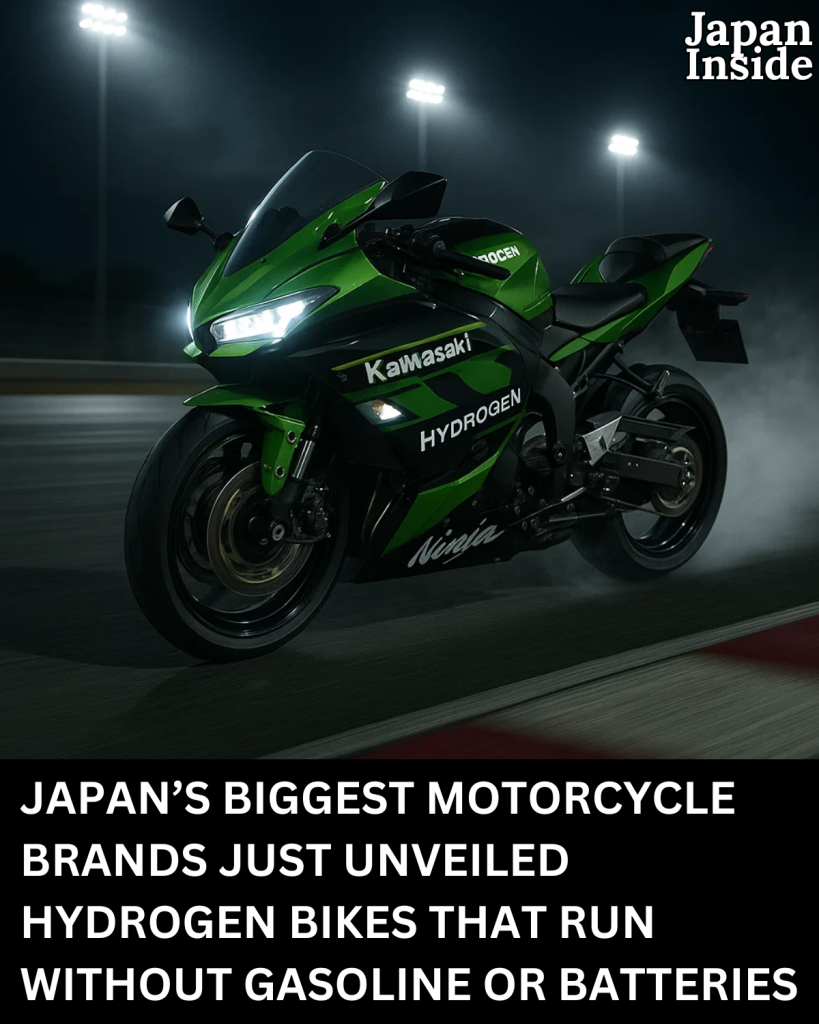Japan’s Biggest Motorcycle Brands Unveiled Hydrogen Bikes That Run Without Gasoline or Batteries
Japan has done it again—this time shaking the foundations of the global motorcycle industry. In a historic move, the four titans of Japanese motorbike manufacturing—Kawasaki, Honda, Yamaha, and Suzuki—have joined forces to launch a new type of motorcycle that doesn’t run on gasoline or electricity. These futuristic two-wheelers are powered by hydrogen internal combustion engines, and they may be the boldest step yet toward a zero-emission world.

The Birth of HySE: A Hydrogen Dream Team
This groundbreaking collaboration is organized under the banner of HySE (Hydrogen Small mobility & Engine technology), a government-approved technology research association. Backed by Japan’s Ministry of Economy, Trade and Industry (METI), HySE aims to develop hydrogen-powered engines tailored specifically for small mobility vehicles, especially motorcycles.
What makes this initiative so unique is the shared R&D approach. Instead of competing, the four companies are openly pooling their knowledge and engineering talent. Kawasaki Motors is leading the engine prototyping, Honda is contributing hydrogen tank innovations, Yamaha is exploring combustion dynamics, and Suzuki is focused on integration within small vehicle platforms.
Not Electric, Not Gas—So What Is It?
Unlike hydrogen fuel cell vehicles that use chemical reactions to generate electricity, these bikes use direct hydrogen combustion. Yes, actual hydrogen is injected and burned in a modified engine—just like gasoline, but with one critical difference: the exhaust is mostly water vapor.
The system includes:
- A high-pressure hydrogen fuel tank
- Injectors that spray hydrogen into the combustion chamber
- A redesigned engine block optimized for hydrogen’s explosive nature
- Reinforced storage systems that manage hydrogen safely and efficiently
This combination allows for powerful performance while eliminating CO₂ emissions.
Why Hydrogen Motorcycles?
Hydrogen offers several advantages over batteries, especially for small, high-performance vehicles like motorcycles:
- Fast refueling time (similar to filling up gas)
- Lighter weight compared to battery packs
- Longer range potential without needing bulky power units
- No rare earth metals required, unlike EV batteries
HySE’s mission is to make hydrogen part of a “multi-pathway” carbon-neutral future, alongside electric and hybrid alternatives.
What’s Happening Now?
In July 2024, Kawasaki publicly demonstrated a hydrogen-powered prototype based on its famous Ninja H2, stunning audiences by running the bike on hydrogen while emitting only steam. Under the hood, a modified supercharged engine with direct hydrogen injection proved that high-performance and clean energy can coexist.
The project’s technical challenges are substantial:
- Hydrogen’s fast flame speed and low ignition energy require precise control
- Storage tanks must withstand high pressure but fit in compact bike frames
- Fuel delivery systems must operate at exact tolerances
But with Japan’s engineering leadership and METI’s support, HySE is accelerating toward real-world readiness.
Global Implications: More Than Just Motorcycles
What makes this even more exciting is the broader application. According to HySE documents, the same technology being tested for motorcycles could eventually power forklifts, drones, mini-wheel loaders, even small aircraft and boats.
This isn’t just about motorcycles—it’s about redefining small mobility worldwide. Japan, which already commands over 50% of global motorcycle production, is positioning itself to lead the next chapter in transportation.
When Can We Ride One?
HySE’s timeline stretches into the early 2030s, with multiple phases of:
- Prototype testing
- Model-based simulations
- Standardization of safety protocols
- Collaboration with universities and international partners
Commercial models may still be several years away, but the foundation has been laid—and it’s built on hydrogen.
This isn’t just a technological breakthrough; it’s a cultural moment. Japan, a country known for its innovation in mobility, is now rewriting the rulebook on what motorcycles can be. No gas. No battery. Just pure hydrogen-powered adrenaline.
Whether you’re a rider, an engineer, or someone who just loves seeing the future take shape, keep your eyes on HySE. Because the next time you see a bike racing by, it might be leaving nothing but mist in its wake.
how about a system that is the shape of a gas tank to replace gas tank?